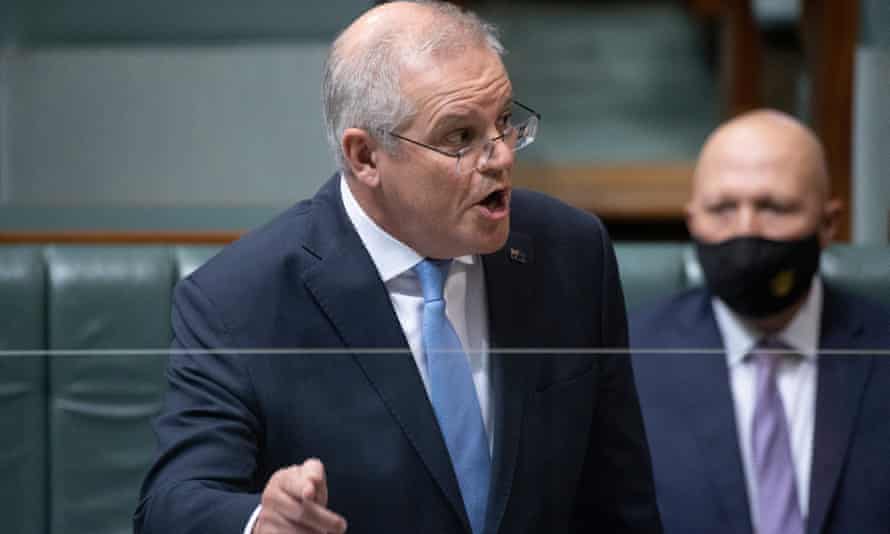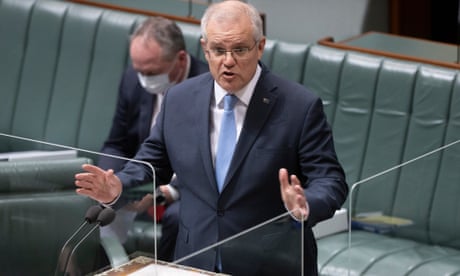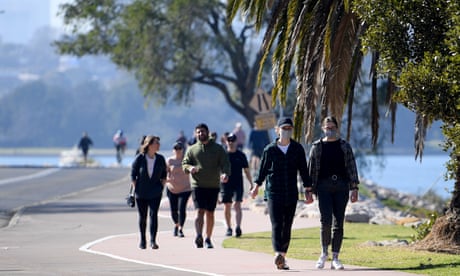In the parable of good and bad premiers, lockdowns must end as soon as we hit 70% vaccination because the Doherty modelling says so. That’s bollocks

Last modified on Sat 4 Sep 2021 06.02 AEST
Given the nation has been treated to a fortnight of posturing and jousting over national cabinet’s four-phase plan to reopen Australia and “live with Covid-19”, let’s do something crazy.
Let’s look at what the plan says.
Before we get to the words, let’s consider what this plan is. It’s possible there’s a more voluminous version locked away somewhere in the national cabinet vault, but the public version of the roadmap is one sheet of A4 paper, with four columns of dot points covering phases A, B, C and D. If you look at the bottom right hand corner of the document, you’ll see this sentence: “The plan is based on the current situation and is subject to change if required.”
This might surprise readers who have endured the idiotic fortnight-long parable of the good premiers (the ones who stick to The Plan) and the bad premiers (who query various elements, or reference the blindingly obvious point that pandemics are uncertain).
In the political telling, through the drone of the execrable Dorothy Dixers and the talking points rolling out the mouths of backbenchers on the ABC News channel, The Plan is like the Bible, or a minor cult. You are either a planner, or a dissenter.

Bear in mind one of the chief architects of the good premiers and bad premiers parable is Gladys Berejiklian, who would much prefer people were bitching about the bad premiers who won’t implement The Plan than interrogating what’s happening in Sydney and regional New South Wales.
From Berejiklian’s perspective, much better that the now mildly unhinged media complex be shrieking and tut-tutting about what a bumpkin Mark McGowan is, the naivety of the man, the provincialism – hasn’t he heard of the Delta strain? – than insisting the premier provide a straight answer to a simple and entirely reasonable question: How many cases, hospitalisations and deaths is she expecting at the peak of the current outbreak, which started in Sydney and spread to Victoria, the Australian Capital Territory and New Zealand?
So here’s insight one: The Plan is not a binding contract drafted by an omnipotent federated hive mind. It’s an A4 page with an explicit get-out-of-jail clause.
Here’s insight two: In the parable of good premiers and bad premiers, lockdowns are bad, and must end as soon as we vaccinate 70% of people over 16, because that’s what the Doherty modelling says and what The Plan says.
Now I regret to inform you that’s bollocks on both counts. Doherty has a visible caution sticker on easing restrictions at the 70% threshold and The Plan anticipates lockdowns in phases A, B and C. Just for clarity, phase A is where we are now and phases B and C happens when vaccination rates move through 70% and 80% of the population aged over 16. Phase A allows for “early, stringent and short lockdowns if outbreaks occur”, while lockdowns are “less likely, but possible” during phase B and “highly targeted only” during phase C.
Insight three brings us to state border closures. Interestingly, the plan is largely silent on this point. There is one explicit reference in phase A, which says “domestic travel restrictions [should be] directly proportionate to lockdown requirements”. The Plan references border restrictions implicitly by noting that restrictions ease when the preferred vaccination thresholds of 70% and 80% are reached both nationally and in the individual state or territory. In plain English, this means states ease restrictions when they hit the vaccination target, so if vaccinations happen more slowly in South Australia than NSW, SA opens later.
I hope that bit of explication helps you filter out at least some of the self-serving narratives we are all drowning in. There’s one more insight into plans and advice I’d like to highlight before we scoot on to considering the point we’ve reached in the pandemic, which is the trigger point for the parable of the premiers.
Australians have heard a lot about the Doherty modelling that informs The Plan, but less about the Treasury advice that accompanied it. My guess is if you’ve heard about the Treasury analysis at all, it will be the oft-repeated line from Scott Morrison and Josh Frydenberg about lockdowns. Morrison and Frydenberg both claim the Treasury advice accompanying The Plan says that at a certain point lockdowns impose more costs than benefits.
Again, I regret to inform you that’s bollocks. Treasury has certainly told the government that once vaccination rates reach 70% “lockdowns are unlikely to be required, significantly reducing the economic cost of managing Covid-19”.
But Treasury is very obviously of the view that sound public health measures is sound economics. Treasury says it is “significantly more cost effective” to manage Delta with public health measures “than allowing higher levels of community transmission to take hold”.
Treasury also made a point of telling the government that “an unmitigated health crisis” – a scenario when an outbreak was so large it overwhelmed the health system – would “harm the economy more broadly”. Just in case this point got lost somehow, Treasury said the “costs of such a scenario would exceed the costs of the most severe lockdown scenarios modelled”.
So let’s just note the Treasury advice, like The Plan, is more nuanced than the daily political translation suggests.
Treasury’s point about the possible risks to the health system brings us neatly to where we are now in this pandemic.
During the national cabinet meeting on Friday, leaders were supposed to consider an assessment about whether the health system is prepared adequately for what’s coming. I gather that report is not yet finished. But officials I trust fear there is not enough intensive care capacity in a scenario where 70% of adults are vaccinated, but tracking and tracing is not working optimally, and restrictions have been eased too quickly. Even if intensive care capacity holds through that turbulence, maintaining a highly skilled workforce is going to be a major challenge.

Because of the incredibly successful suppression efforts in the first and second waves, Australia would have hoped to keep case numbers low while the population got vaccinated. That’s not going to happen. The king of elimination, the Victorian premier Daniel Andrews, acknowledged this week it can’t be done. This Delta outbreak has not yet peaked. We are looking at thousands of infections, a substantial number of hospitalisations, and deaths.
The Guardian Essential poll suggests Australians are concerned about any “living with Covid” strategy that leads to a significant increase in hospitalisations and deaths. Channelling that anxiety, and wanting to rebut the self-interested Berejiklian bad premier casting, Annastacia Palaszczuk this week declared that if the libertarians had their way, 80 people would die each day six months after the outbreak.
This, too, was bollocks.
Palaszczuk cherrypicked one scenario from the Doherty modelling not entirely accurately, and certainly devoid of the necessary context. Given there’s so much selective citing around about The Plan, the Doherty assessment, the Treasury analysis – inputs that have been shunted and distorted through the misshapen ad hoc modelling of intraday pandemic politics, rubbish in, rubbish out – the Queensland premier didn’t need to add more.
But the frustration Palaszczuk and McGowan have expressed this week is understandable.
Literally five minutes ago, Australia’s primary objective was aggressive suppression, and the preservation of lives and livelihoods. This was a point of national pride, and these two premiers have built their brands around being political leaders who conquered Covid (which was a brand Morrison planned on taking to the next federal election, before he stuffed up the vaccine rollout).
A national reopening plan that gave all the premiers some discretion in how they pilot towards Covid-normal is also being reframed in the court of daily soundbites as a set of absolutes, as an arbitrary test that premiers pass or fail.
Obviously Delta makes its own rules, and Australia needs to adapt to a new reality that isn’t really negotiable. Given the risks the variant poses, Palaszczuk and McGowan need to vaccinate their people as fast as supply allows.
But it’s also true that when Sydney and Canberra are very obviously dictating the new terms of Australia’s pandemic pivot, politically that’s a dynamic that never plays well up north and out west.
No comments:
Post a Comment